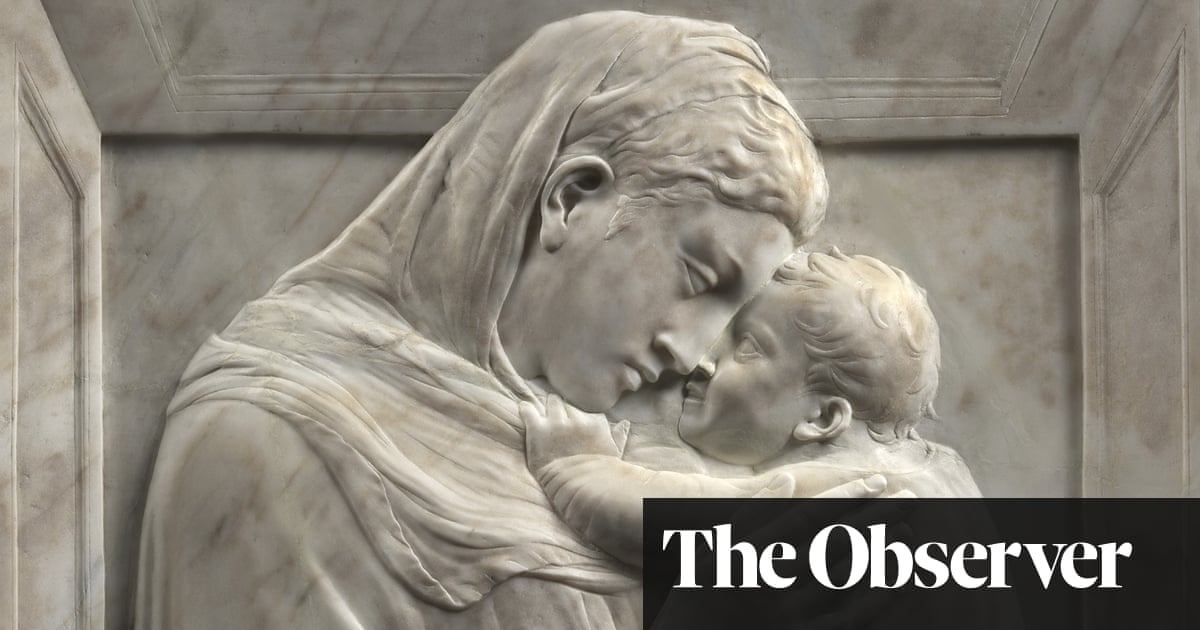
Astartling figure has arrived in Britain: a man with a gathering frown, sleepless thoughts and a graze of stubble. His eyes are downcast, his domed forehead lowered. You would recognise him anywhere in the streets of his native Italy: the pensive intellectual, dark-eyed and ascetic, with a tousled black beard. Except that he is from the 15th century, and cast in gleaming gilded bronze.
The original commission was for a medieval reliquary – an object to contain the remains of a saint, in this case the skull of San Rossore, a Roman soldier who converted to Christianity and was martyred for his faith. But the sculptor, Donatello, exceeded every rule and convention. Not only did he imagine the saint as a once-living being, not an icon, but he created this staggering portrait of a real modern man in the active moment of thinking.
The sensation of walking round this being as his aspect changes, as if to chime with his ever-moving thoughts, will be possible with an epochal show opening at the V&A on Saturday. Donatello: Sculpting the Renaissance is the first substantial exhibition of the Florentine master’s art ever mounted in Britain. Anyone who has seen even a handful of the figures he made on every scale, and in every medium, all through Italy during his long and prolific career, knows this will be a show of pure amazement.
Donatello (c1386-1466) is the most revolutionary of all Italian sculptors. Born in Florence, the son of a wool carder, he was apprenticed to Lorenzo Ghiberti during the creation of the great bronze doors of the Baptistery. Donatello’s most famous figure is probably the young David in black bronze, the first standing male nude in Renaissance art, got up in nothing but a swagger hat and boots. Outstandingly seductive, in all his lithe beauty, this David was made to be seen in the round by everyone passing through a Medici palace courtyard. He came to symbolise political bravery against tyrannical giants.
The London show will open with a greater David, however. Larger than life, and carved out of marble, this youth rises above you with a balletic sway, amaranth leaves threaded through his curls, head self-consciously tilted as if posing for a camera. The stance is all grace, the torsion amazing as you circle the figure, wondering how Donatello could turn stone into something as supple as warm skin and velvet. His chisel describes the exact tension of lacings through eyelets, the pooling of fluted silk, the long line of the thigh, the foot turned ever so gently upon the severed head of Goliath – not dead, only sleeping, as it seems. The sculpture shifts between religion and myth, between public statue and mysterious portrait. It feels perpetually restless.
All of Donatello’s figures seem to yearn for more than the ordinary life of a sculpture. One of his earliest commissions was to carve a dead Christ for the facade of a Florentine church. His messiah appears to be breaking free of the marble from which he is made, moving forwards in space. Donatello’s works were nearly all designed for locations well above eye height and he is known to have made adjustments in situ to bring the figures into a more dramatic and personal relationship with the viewer. He has a genius for perspective.
An immense crucifix from the high altar of a church in Padua, included in the London show, has exactly this exceptional combination of intimacy and remoteness. The dead Christ soars above the viewer, ineffably divine; and yet the sculptor brings him down so close to us, noticing the ragged tatter of the loin cloth, the fraying fibres of the rope, the poor strained arteries and the massive weight of the nails, the overwhelming passage of pain through Christ’s face, with the fading of his mortal life.
Donatello seems an elusive and contradictory figure, even now; supposedly uninterested in literature and yet so sophisticated he dined with the Medici and produced the most refined of all sculptures for them. Supposedly “rough and very straightforward”, according to one contemporary, yet also so sensitive to male beauty it seems absurd to sidestep the suggestion that he was gay.
One persistent anecdote, from Vasari, has him shouting at his statues to come alive. But this makes him sound like any old sculptor from Pygmalion onwards, bent only on a speaking likeness. Donatello was far more radical and inventive. The most breathtaking of all his experiments is in schiacciato, where sculptures are carved in the finest possible relief. Others had done it before, but never with such prodigious subtlety. Donatello’s reliefs are only millimetres deep.
And the V&A owns one of his most astonishing: The Ascension With Christ Giving the Keys to St Peter, so diaphanous, so translucent, carved from a thin sheet of white marble. Water flows, breezes rustle, the figures are as spectral as ghosts in their fragile garments, yet each has its distinct appearance, its own special force of personality. The angels are as nebulous as the clouds in which they hover and a breath of air flows through the whole scene. The vision appears static and yet there are internal shadows everywhere and the surface seems to flicker as you move: a film, conceived in obdurate marble.
Donatello made some of the strangest sculptures in art. Among the exhibits at the V&A will be his outlandish hybrids of ancient and modern. St John the Baptist is the wildest fusion of classical Roman statue and haloed boy saint, draped in a soft, tufted fleece. Nobody really knows what the artist’s weird cherub in leather chaps (arriving from Florence) is supposed to be, or to mean. But his tiny Spiritello (from Berlin), fairly bursting with mirth as he shakes his tambourine, has more joy in its single up-curled toe than many a grander bronze.
Donatello was industrious, prolific, long-lived. His figures are widely scattered all over Italy, from Naples to the far north. This is a problem for anyone trying to get a sense of his extraordinary mind, stunned by the stirring expressiveness of his figures in Florence, say, then losing sight of him in the south. So the V&A show is the chance of a lifetime, to bring Donatello into focus.
He carved a Virgin who was old, worn down, heart burdened, hands veined and knotted. He pictured saints as children and martyrs as emaciated intellectuals, heroes as callow teenagers. He understood what it was to have suffered, and how to epitomise grief and courage in a human figure that achieves a direct relationship with our own. What Donatello took from the past, and what he gave to the future, was human empathy: the emotions of our lives bodied forth in three dimensions.
Donatello: Sculpting the Renaissance is at the V&A, London, from 11 February to 11 June












